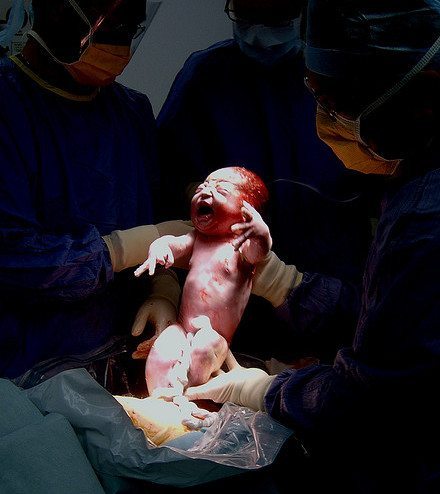World Cesarean Section Awareness Month
Spring is a busy season for awareness events related to birth injury and children’s health—between March and May, we celebrate and recognize awareness endeavors including, but not limited to, cerebral palsy (CP), intellectual and developmental disabilities (I/DD), traumatic brain injury (TBI), ending the “R” word, Down syndrome, autism, mobility challenges, and children’s mental health. Today, our team of birth trauma experts at Michigan Cerebral Palsy Attorneys will focus on one April awareness event in particular—World C-Section Awareness Month 2015.
Facilitated by the International Cesarean Awareness Network, C-Section Awareness Month aims to promote education and awareness about the indications, risks, benefits, and culture surrounding the C-section operation. C-Section awareness endeavors also work to provide thorough, informed information on VBAC (Vaginal Birth After Cesarean) deliveries including its risks, support, recovery, benefits, and indications.
In support of C-Section Awareness Month, our birth trauma and cerebral palsy experts will discuss the basics of C-sections, VBAC deliveries, and birth injury lawsuits related to the operation. As always, we encourage you to reach out to our team with any questions, concerns, or case inquiries.
What is a C-Section?
 Cesarean sections (C-sections) are operative procedures in which surgeons deliver babies through a mother’s abdomen and womb by means of one or more incisions. Most commonly performed in instances when vaginal delivery is dangerous to the mother or child, C-sections can be life-saving to both the baby and the mother. Sometimes mothers and doctors plan Cesarean deliveries in advance, while other times dangerous labor and delivery situations require the performance of emergency C-section operations.
Cesarean sections (C-sections) are operative procedures in which surgeons deliver babies through a mother’s abdomen and womb by means of one or more incisions. Most commonly performed in instances when vaginal delivery is dangerous to the mother or child, C-sections can be life-saving to both the baby and the mother. Sometimes mothers and doctors plan Cesarean deliveries in advance, while other times dangerous labor and delivery situations require the performance of emergency C-section operations.
A few conditions and complications that necessitate the performance of a C-section include macrosomia, shoulder dystocia, placenta previa, prolonged labor, abnormal fetal presentation (such as breech or face presentation), cephalopelvic disproportion (CPD), preeclampsia, umbilical cord problems (nuchal cords, compressed cords, short cord length, and prolapsed cords), and fetal oxygen deprivation.
Which C-Section Mistakes May Lead to Birth Injury?
The American College of Obstetricians and Gynecologists (ACOG) recommends that a C-section operation begin within a thirty minute time frame of the decision to perform the surgery. However, emergency complications often require a faster delivery in order to prevent injuries such as hypoxic ischemic encephalopathy (HIE) and cerebral palsy (CP). Delayed emergency C-sections are instances of medical malpractice that commonly cause fetal oxygen deprivation, brain damage, intellectual impairments, developmental delays, cerebral palsy, and other lifelong disabilities and injuries. Delayed emergency C-sections (or the failure to offer and perform C-section delivery) may be the consequence of poorly equipped hospitals, fetal heart monitoring errors, or other dangerous medical mistakes.
What Is a VBAC Delivery?
Vaginal Birth After Cesarean (VBAC) delivery is, as it sounds, the vaginal birth of a baby by a mother who has previously delivered via C-section. Safe candidates for VBAC delivery generally meet a few qualifications that relate to previous vaginal deliveries, C-section scar placement, time elapsed from the previous C-section, risk factors, and more. While experts agree that roughly 60-80% of women are safe candidates for VBAC delivery, mothers and physicians are urged to carefully consider the choice to deliver vaginally. The potential injuries associated with an unsuccessful VBAC delivery include uterine rupture, emergency C-section delivery, maternal infection, and fetal infection.
More on C-Sections, VBAC Deliveries, and Medical Malpractice Lawsuits
Further Reading for C-Section Awareness Month
 In the spirit of C-Section Awareness Month, our team of Michigan birth injury lawyers and experts encourage readers to check out the following informational articles and pages:
In the spirit of C-Section Awareness Month, our team of Michigan birth injury lawyers and experts encourage readers to check out the following informational articles and pages:
- Birth Injury from C-Section Mistakes
- Birth Injury from VBAC Mistakes
- Michigan Cerebral Palsy Attorneys: Our Past Lawsuits
- Verdicts and Settlements: Delayed Emergency C-Section
- Verdicts and Settlements: Failure to Offer C-Section Delivery
- Verdicts and Settlements: Vaginal Birth After Cesarean (VBAC) Delivery Injuries
